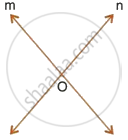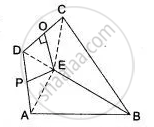Advertisements
Advertisements
प्रश्न
ΔPBC and ΔQBC are two isosceles triangles on the same base BC but on the opposite sides of line BC. Show that PQ bisects BC at right angles.
उत्तर
Given: Two ΔSPBC and QBC on the same base BC but in the opposite sides of BC such that PB = PC and QB = QC.
To prove: PQ bisects BC and is ⊥ to BC.
Proof: Since, the locus of points equidistant from two given points is the perpendicular bisector of the segment joining them. Therefore, ΔPBC is isoceles
⇒ P lies on the perpendicular bisector of BC
ΔQBC is isoceles ⇒ QB = QC
⇒ Q lies on the perpendicular bisectors of BC
∴ PQ is the perpendicular bisectors of BC
Hence, PQ bisects BC at right angles.
Hence proved.
APPEARS IN
संबंधित प्रश्न
Construct a triangle ABC, in which AB = 4.2 cm, BC = 6.3 cm and AC = 5 cm. Draw perpendicular bisector of BC which meets AC at point D. Prove that D is equidistant from B and C.
Use ruler and compasses only for this question.
- Construct ΔABC, where AB = 3.5 cm, BC = 6 cm and ∠ABC = 60°.
- Construct the locus of points inside the triangle which are equidistant from BA and BC.
- Construct the locus of points inside the triangle which are equidistant from B and C.
- Mark the point P which is equidistant from AB, BC and also equidistant from B and C. Measure and record the length of PB.
The given figure shows a triangle ABC in which AD bisects angle BAC. EG is perpendicular bisector of side AB which intersects AD at point F.
Prove that:

F is equidistant from A and B.
Draw a line AB = 6 cm. Draw the locus of all the points which are equidistant from A and B.
Describe the locus of points at distances greater than 4 cm from a given point.
In the given figure, obtain all the points equidistant from lines m and n; and 2.5 cm from O.

In a quadrilateral PQRS, if the bisectors of ∠ SPQ and ∠ PQR meet at O, prove that O is equidistant from PS and QR.
In Fig. ABCD is a quadrilateral in which AB = BC. E is the point of intersection of the right bisectors of AD and CD. Prove that BE bisects ∠ABC.
Find the locus of the centre of a circle of radius r touching externally a circle of radius R.
ΔPBC, ΔQBC and ΔRBC are three isosceles triangles on the same base BC. Show that P, Q and R are collinear.
